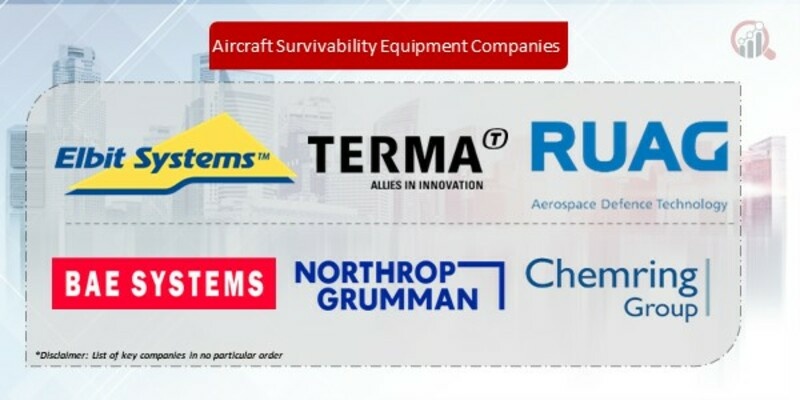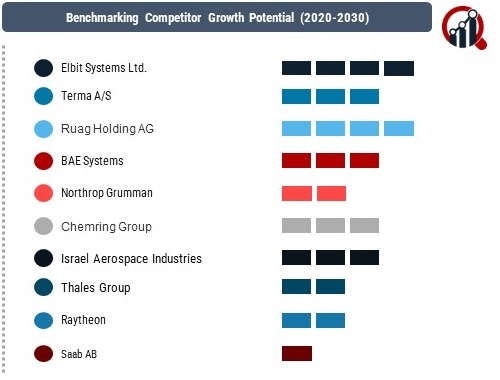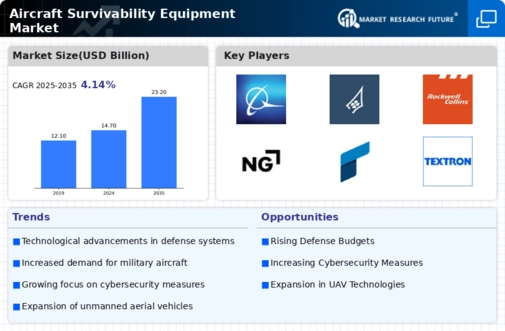Top Industry Leaders in the Aircraft Survivability Equipment Market

Key Players
Elbit Systems Ltd. (Israel),
Terma A/S (Denmark)
Ruag Holding AG (Switzerland)
BAE Systems (US)
Northrop Grumman (US)
Chemring Group (UK)
Israel Aerospace Industries (Israel),
Thales Group (France)
Raytheon (US)
Saab AB (Sweden)
Northrop Grumman
Strategies Adopted
In the competitive ASE landscape, strategies adopted by key players play a pivotal role in shaping market dynamics. Technological differentiation remains a core strategy, with companies investing heavily in research and development to introduce state-of-the-art solutions. Northrop Grumman, for example, emphasizes continuous innovation, developing advanced jamming systems and threat warning technologies to stay ahead in the electronic warfare domain.
Strategic partnerships and collaborations are another key facet of the competitive landscape. Companies forge alliances with defense organizations, research institutions, and other industry players to leverage complementary capabilities and broaden their market reach. Raytheon Technologies, through strategic collaborations, enhances its ability to deliver integrated ASE solutions, ranging from infrared countermeasures to missile warning systems.
Cost-effective solutions and flexibility in adapting to diverse aircraft platforms are also crucial strategies. Saab AB, for instance, focuses on providing scalable and adaptable ASE solutions that cater to a wide range of aircraft, ensuring compatibility with varying defense requirements.
Factors for Market Share Analysis
Analyzing market share in the ASE sector involves considering multiple factors that influence a company's standing. Technological leadership is a primary determinant, as companies offering cutting-edge solutions tend to capture a larger market share. Additionally, a broad portfolio that covers different facets of survivability, such as radar warning systems, infrared countermeasures, and laser warning systems, enhances a company's competitive position.
Global presence and strategic partnerships contribute significantly to market share, enabling companies to address diverse customer needs and expand their geographical footprint. Moreover, successful execution of government contracts and the ability to meet stringent military standards play a vital role in gaining and retaining market share. Factors like customer satisfaction and support services also contribute to a company's overall competitiveness.
New and Emerging Companies
The ASE market is witnessing the emergence of new and agile companies that bring fresh perspectives and innovative solutions. These companies often focus on niche areas within survivability, addressing specific threats or incorporating novel technologies. L3Harris Technologies, for example, has gained prominence with its expertise in electronic warfare and integrated avionics.
Start-ups such as Vanquishtech and DefendTex are disrupting the market with their nimble approaches. Vanquishtech specializes in advanced radio frequency countermeasures, while DefendTex focuses on lightweight and modular solutions. These emerging players challenge traditional norms, injecting dynamism into the market and compelling established companies to adapt and innovate.
Industry News
Staying abreast of industry news is vital for understanding the evolving dynamics of the ASE market. Recent developments include advancements in artificial intelligence and machine learning applied to threat detection and countermeasure deployment. These technologies enhance the speed and accuracy of ASE systems, a critical factor in the face of evolving and sophisticated threats.
Moreover, industry news reflects the market's response to geopolitical shifts and global security challenges. The incorporation of cyber-resilient features in ASE solutions and the development of multi-domain capabilities are examples of how companies are adapting to the changing threat landscape. Ongoing international collaborations and joint ventures also shape the competitive scenario, influencing the distribution of market share among key players.
Current Company Investment Trends
Investment trends in the ASE market mirror the industry's commitment to innovation and adaptability. Companies are allocating substantial resources to research and development, with a focus on next-generation technologies. Investments in machine learning, artificial intelligence, and quantum technologies are on the rise, indicating a concerted effort to stay ahead of emerging threats.
Global partnerships and acquisitions are prevalent investment strategies, allowing companies to integrate complementary technologies and broaden their product offerings. Raytheon Technologies' acquisition of advanced threat detection specialists, as well as Saab AB's partnerships to enhance electronic warfare capabilities, exemplify this trend. Additionally, investments in cybersecurity measures and resilient communication systems underline the industry's recognition of the interconnected nature of modern warfare.
Overall Competitive Scenario
In conclusion, the competitive landscape of the Aircraft Survivability Equipment market is characterized by a dynamic interplay of innovation, strategic partnerships, and technological prowess. Key players like Northrop Grumman, BAE Systems, Raytheon Technologies, and Saab AB continue to shape the market through their differentiated strategies and extensive portfolios.
The emergence of new and agile companies introduces a level of unpredictability, driving established players to continually innovate and adapt. Industry news highlights the sector's response to geopolitical shifts and evolving threats, while current investment trends underscore the commitment to cutting-edge technologies and global collaboration. As the ASE market evolves, companies that navigate these complexities, stay at the forefront of technological advancements, and maintain strategic agility are poised to lead in this critical segment of the aerospace and defense industry.
Recent News
Northrop Grumman Corporation (NOC)
Unveiled the B-21 Raider bomber equipped with advanced radar jamming and laser countermeasures, designed to penetrate heavily defended airspace and deliver payloads undetected.
Partnered with Raytheon Technologies to develop a new generation of active electronically scanned array (AESA) radars for fighter jets, offering superior situational awareness and threat detection.
BAE Systems plc (BAE)
Won a contract to upgrade the electronic warfare suite of the Eurofighter Typhoon, bolstering its ability to disrupt enemy radars and communications.
Collaborating with the UK Ministry of Defence to develop a new generation of counter-electronics systems for various platforms, aiming to disrupt emerging threats like drones and cyber attacks.
Thales Group (HO)
Launched the SPECTRA radar warning receiver, offering enhanced threat detection and identification capabilities for various aircraft types.
Developed a new decoy system that generates realistic radar and infrared signatures, confusing enemy sensors and protecting aircraft from missile attacks.
Other Key Players
Companies like Leonardo S.p.A. (Italy), Rafael Advanced Defense Systems Ltd. (Israel), and Elbit Systems Ltd. (Israel) are actively developing and offering diverse aircraft survivability equipment, from missile countermeasures to directed energy weapons.
Smaller startups are focusing on niche technologies like advanced jamming techniques, artificial intelligence-powered threat analysis, and cyber-secure communication systems


